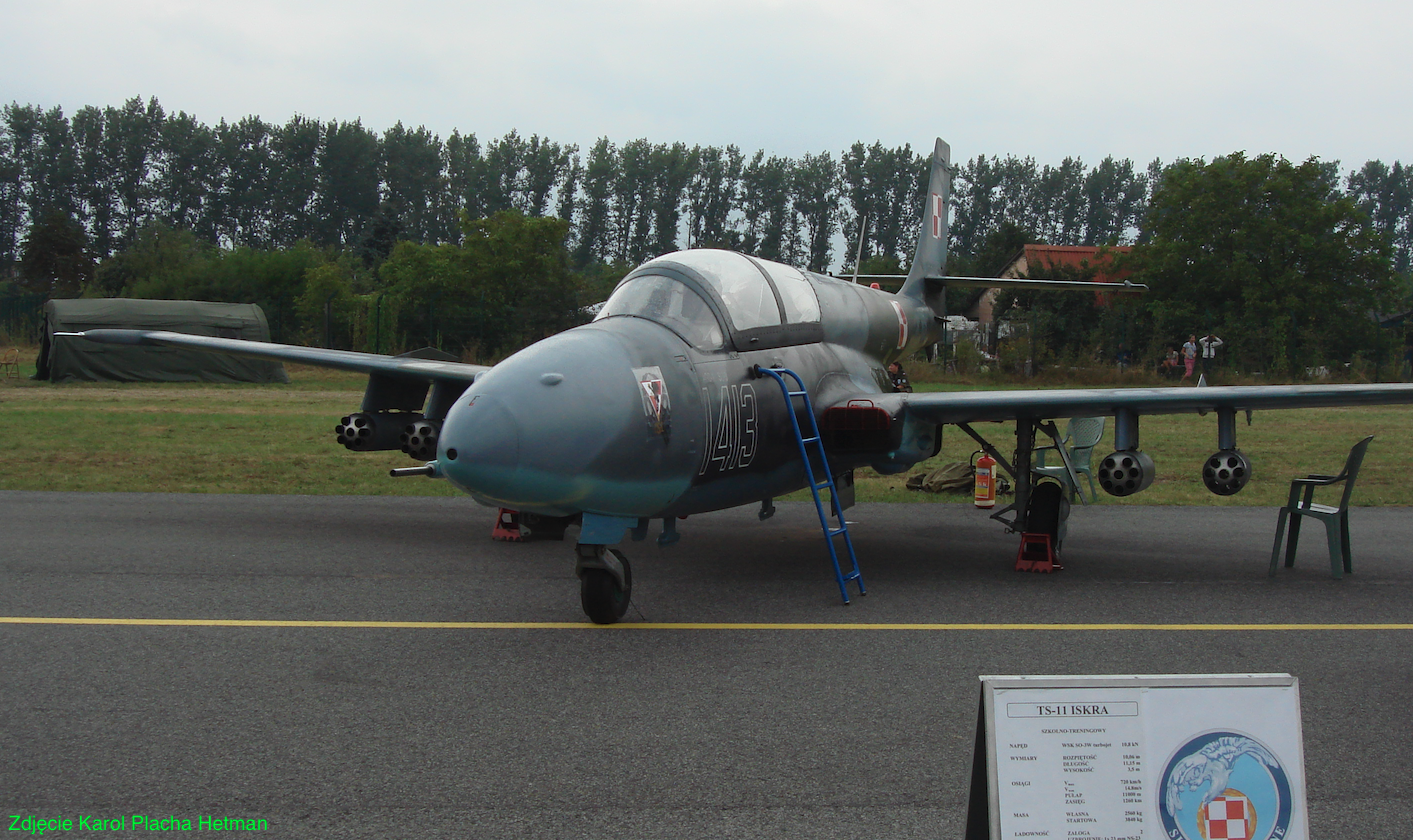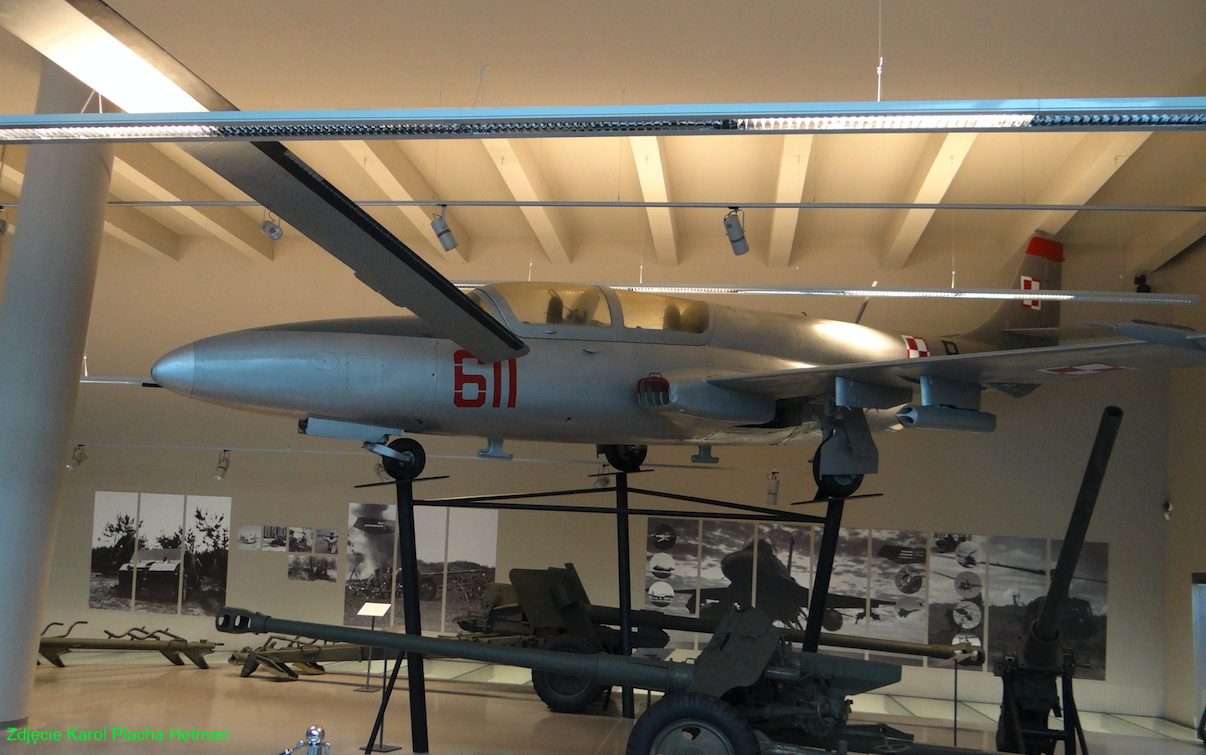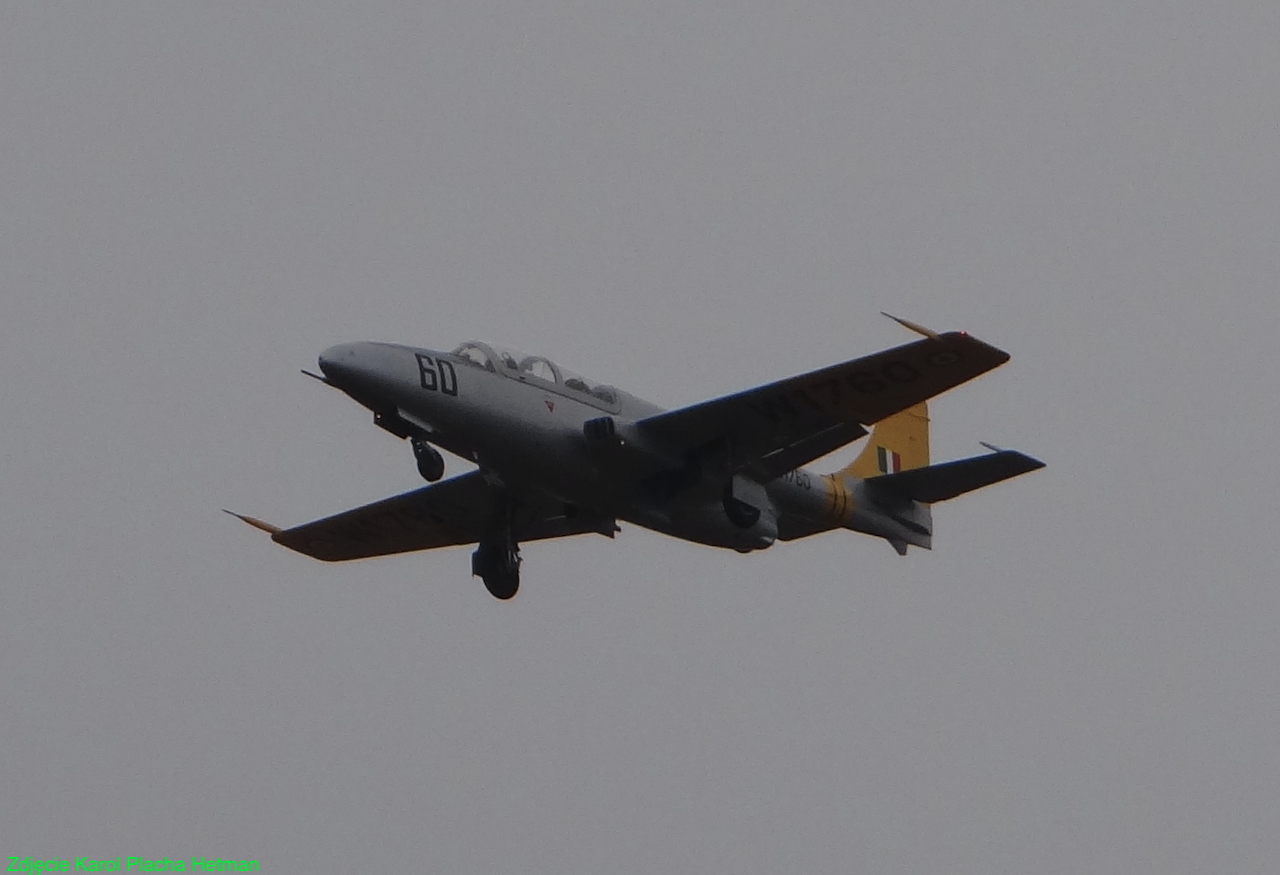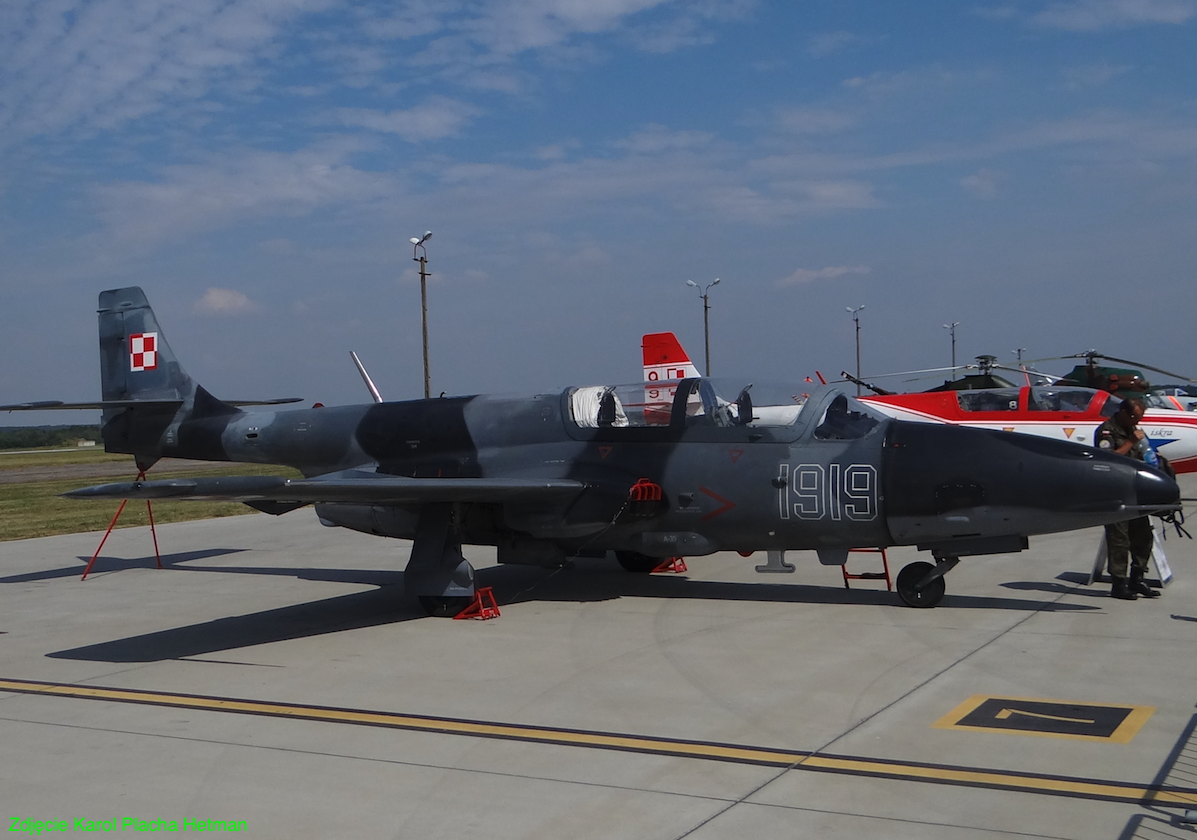Kraków 2009-11-22
PZL WSK Mielec TS-11 Iskra.
171b Section 5 February 1960 year. Trainer and combat aircraft.

TS-11 Iskra versions.
In 1968, the TS-11 Iskra bis B aircraft, the prototype was designated TS-11 Iskra 100.
At WSK Mielec it was noticed that training aircraft were starting to be used to support land forces. In 1968, an armed version was created; training and attack aircraft, designated TS-11 bis Iskra B. The prototype of this version was designated Iskra 100. It was an aircraft rebuilt from the TS-11 No. 1H 04-05. The first flight was made on June 26, 1968. The plane received four weapon suspension nodes. Typical armament consisted of 2 x 500 kg bombs and containers with e.g. 2 x 4 missiles. This version was ultimately produced from the fifth series, i.e. from the TS-11 machine no. 1H 05-01.
In 1971, TS-11 Iskra bis C, the prototype was designated TS-11 Iskra 200 Art.
The Iskra 200 / Iskra 200 Art model was developed for reconnaissance tasks. The machine serves as photo-reconnaissance and artillery fire correction. The control devices were removed from the second cabin, and in their place a dashboard and reconnaissance equipment operating instruments appeared. This dashboard is actually a map table that can be locked at various angles. Important equipment includes three AFA-39 cameras, also operated by the operator in the second cabin. The first prototype was the TS-11 No. 1H 05-30. The aircraft entered production under the designation TS-11 Iskra bis C and 33 machines were built in two series. The first production series of the TS-11 bis C was the tenth series 1H 10-..., in which 21 machines were built, giving a total of 222 aircraft.

Then an eleventh series was created, consisting of 12 machines, giving a total of 234 planes.
In 1972, TS-11 Iskra BR 200.
In the 1970s, a single-seat reconnaissance and attack prototype was developed. The controls and instrument panel were removed from the second cabin. An additional fuel tank was installed there. The plane received 3 AFA-39 cameras. The armament included 100 kg bombs, 8-barreled Mars 4 launchers, and artillery pods. The aircraft is powered by an SO-3 B engine with increased thrust of 1 x 1079 - 1,100 kG. The Iskra 200 BR nb 0823 prototype was first flown on June 22, 1972. It was planned to build a series of 5 copies. The prototype was exhibited for the first time at the Polish Production Aircraft Review, organized at the airport in Mielec on May 28 - June 4, 1972, by the Union of the Aviation and Engine Industry "Delta". The aircraft was also exhibited at the Central Military Exhibition of Inventions and Rationalization in Warsaw in September and October 1973. It was then that the aircraft had a cartridge case mounted for the first time. This plane was also an export proposition.

In 1973, TS-11 Iskra bis D, the prototype was designated TS-11 Iskra 200 SB.
It is a two-seat combat training or training-assault version. Compared to the bis B version, the engine capacity has been increased. This version served as the base for the development of a national version for the Indian Air Force, where the aircraft entered service in 1976.
On September 19, 1973, the Iskra 200 SB prototype was flown, created by rebuilding the 1H 07-20. The plane was then built in series as Iskra bis D and Iskra bis DF. In terms of armament, the aircraft is identical to the Iskra 200 BR, but it has a two-seat cabin and is a training aircraft. The Iskra 200 DF version additionally received three AFA-39 cameras.
In 1974, TS-11 Iskra bis DF.
A desktop for the navigator was installed in the second cabin. Three AFA-39 cameras were mounted under the fuselage. The plane also received other equipment. One of them was a device that responded to a code query, i.e. one-sided identification. Currently, this device is called a transponder. This plane was exhibited at the Poznań International Fair in June 1976.
Serial production of the TS-11 bis D/DF began after 50 machines were built for export to India. It was 1976. The counting of the series continued, but the beginning of the serial number was different, namely 3H. The twelfth production series consisted of 33 machines, numbers 3H 12-01 to 3H 12-33. A total of 317 machines were built, including export aircraft.
The next series was the fourteenth series, because the thirteenth issue was not broadcast. The series consisted of 15 machines, giving a total of 332 planes.
The fifteenth series also consisted of 15 machines, which gave 347 aircraft. The series was created in 1977.
The sixteenth series consisted of 26 machines, which gave 373 aircraft, and was also created in 1977.
The seventeenth series consisted of 22 machines, which gave 395 aircraft. The series was created in 1978 and production was stopped.
After a break of several years, production of Iskra aircraft was resumed. This was due to the natural decline of machines and the resumption of the arms race. In 1982, the eighteenth series was created, but only of TS-11 bis DF aircraft. It consisted of 21 machines, which gave a total of 416 serial aircraft.
In the period 1984-1985, the nineteenth production series was created, consisting of 19 machines, which gave a total of 435 machines.
In the period 1987-1988, the last production series, the twentieth, was created, consisting of 14 machines, which gave a total of 449 aircraft. No further TS-11 series were produced as the production of its successor, the I-22 Iryda, was approaching. Ultimately, Freemasonry blocked the production of I-22 Iryda aircraft.
In 1976, TS-11 for India.
Foreign countries were very interested in the TS-11 Iskra aircraft. Especially the so-called third world countries. Already in the first half of 1972, a military delegation of the Republic of Iran visited, among others, WOSL in Dęblin, showing particular interest in the TS-11 aircraft.
In 1973, Poland was visited by the Chairman of the Joint Armed Forces of Peru, Major General Arturo Cavero Calixto. He was a guest of, among others, the 1st PLM Warsaw, where he became thoroughly familiar with the TS-11 aircraft.
In 1975, the Indian Air Force bought 50 TS-11s. These aircraft entered service in 1976 and served continuously until December 16, 2004, when their operation officially and ceremonially ended. The transaction with India meant great recognition for Polish flying equipment. The success was even greater because India, having its own developed aviation industry, produced its own turbojet-powered training aircraft, the HAL Kiran, and the Folland Gnat aircraft under license. The first batch of TS-11 aircraft was sent back to India at the end of September 1975. At the same time (September 30, 1975), a delegation of the Indian Parliament was in Poland and visited the WSK-PZL Mielec plant. The aircraft production process was demonstrated and the progress of the contract was presented.

In 1992, TS-11 Iskra R.
The aircraft was created on the basis of the TS-11 bis DF specifically for naval aviation, as a temporary solution due to the lack of appropriate equipment in reconnaissance aviation. This makeshift solution lasted for 11 years. No new units were built, only existing aircraft were improved. The plane received an RDS-81 weather radar of American production. It is operated by an airman in the second cabin. The machine also received a GPS satellite navigation system.
This version is inextricably linked with Naval Aviation. It was for the needs of naval pilots that 6 TS-11 Iskra R units were created, numbered 19-09, 19-10, 19-13, 19-17, 19-18, 19-19. These planes were sent to the 3rd Air Squadron in Siemirowice, where they served for eleven years. This squadron also had typical TS-11 bis DF planes in service, numbers 14-10, 14-11, 14-13, 17-16, 17-22, 18-02, 18-03, 18-05, 20-11 , 20-12, 20-13, i.e. 11 machines. All planes used in Siemirowice had camouflage, and from 1999, after Poland joined NATO, the white NAVY inscription.

TS-11 Iskra MR.
A small number of machines are equipped with modified avionics that meet ICAO standards. This allows planes to move freely almost anywhere in the world. These planes are used by the Biało-Czerwone Iskry aerobatic team. There is a separate chapter about the Biało-Czerwone Iskry team.
TS-11 Iskra Jet / TS-11 Spark.
The planes withdrawn from military service were stripped of their weapons and put up for sale to civilian users through the Military Property Agency. The planes went to, among others, the USA and Australia. There are also fans of these planes in Poland who, having the appropriate cash, have been discovering the joys of flying this plane since May 2006.
TS-11 aircraft demonstrations.
The first public presentation of the TS-11 Iskra aircraft took place on September 11, 1960, when the plane was shown in flight on the occasion of the Aviation Day over Łódź.
The TS-11 aircraft were first shown in a group flight on July 22, 1964, on the occasion of the 20th anniversary of the Polish People's Republic. Four TS-11 planes in the Romb formation demonstrated their flight at Defilad Square in Warsaw.
On July 22, 1966, during the parade celebrating the 1000th anniversary of the founding of the Polish State, the flight of 16 TS-11 planes was demonstrated. The piece demonstrated was a white and red chessboard. The first and last fours had their bottoms painted white, and the side fours had their bottoms painted red. Aerobatics on the TS-11 were demonstrated by test pilots from the Mielec factory; Zygmunt Koraba, Zbigniew Nowakowski, Tadeusz Pakuła, Andrzej Pamuła, Jerzy Rogowski. The flight in military formation was led by pilot major Krzysztof Jurek. On July 22, 1974, during the parade celebrating the 30th anniversary of the Polish People's Republic, a group of TS-11 aircraft flew at the head of the parade. One of the examples, the TS-11 bis DF aircraft No. 1H 09-22 in 1975, received the civilian markings SP-DOF and was repeatedly demonstrated at exhibitions abroad. In September 1976, he was at the Farnborough International Air Exhibition, in 1977, at the Paris Air Show, and in 1978, again in Farnborough. This aircraft was demonstrated several times at the Poznań International Fair. It was also shown at the Exhibition of Achievements of the Polish Aviation Industry at Okęcie on November 15-16, 1979. By mid-1977, TS-11 aircraft had logged over 100,000 hours in the air.
TS-11 flight simulator. 1994.
On January 11, 1994, after completing the qualification tests in Dęblin, the TS-11 Iskra flight simulator was put into operation by WOSL. The simulator is entirely of Polish design and production. Made by Aerospace Industries Ltd from Warsaw. The device is equipped with a sound simulation system, a three-channel collimation visualization system with an image generator based on Silicon Graphics computers and a hydraulic system for simulating forces on steering instruments. It has an imitator of all aircraft instruments and installations and a weapons simulation system. It allows you to learn piloting in its full scope, starting from pre-flight and take-off procedures, through all phases of flight to landing. It can be used to train behavior in all dangerous and emergency situations, which is not done in a real flight due to the too high risk. The first "flight" on this device was performed by the school's commandant, General Edward Hyra.

Written by Karol Placha Hetman
